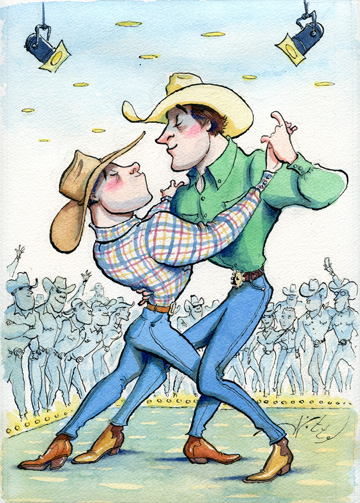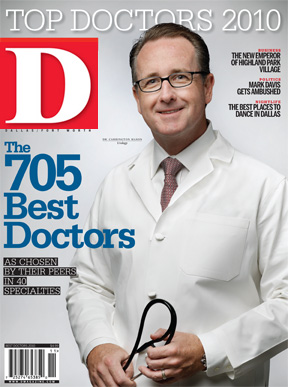Do you wanna dance? not disco, but old-fashioned C&W. I am a longtime fan. Not necessarily of the costumes, but I find the music and the moves irresistible.
Over the decades, one place at the top of my list for out-of-town visitors (including Pulitzer Prize-winning poets and other literati) has been the Round-Up Saloon, Dallas’ premier gay western dance club. Gay for the most part, but everyone is welcome; everyone goes away amazed.
I must have gone there for the first time shortly after it opened, in the early ’80s. Cedar Springs was different in those days: grimmer and grimier, more dangerous, and very badly lighted. The Gay Strip was in the process of establishing itself. Now you can’t even find a parking space. Over the past decades, through fires and renovation, through the prohibition of smoking indoors (hooray!), the Round-Up has grown in size and fame. What has not changed is its raison d’être: this is Country Music Central.
For someone like me, old enough to have learned proper “ballroom” etiquette (i.e., partner dancing), the years between 1960 (when Chubby Checker recorded “The Twist” and couples stopped holding hands on the dance floor) and the present have been a bad memory. In this half-century partnering has fallen out of favor. Two centuries ago, when the waltz came to Europe, it scandalized proper society: men and women were touching one another. Now they seldom do—at least on the dance floor.
Dancing With the Stars and So You Think You Can Dance have shifted the balance, at least a little. At C&W places everywhere, time has stood still. Couples whirl and twirl around the floor. At The Round-Up, that floor is small. Its size tests dancers, who must have bat-like radar to slide and move, revolving and rotating at the same time, without colliding into other couples. When you’re wearing a cowboy hat, it’s even harder to avoid accidents, but these guys make an art of it.
And the fact that they are—for the most part—men may be, initially, the most engaging, but finally, the least interesting thing about them. Dancing is dancing. Who leads, who follows—it’s hard to know. And to the viewer, it doesn’t matter.
The Saturday night of Memorial Day weekend was prime time. Summer had just begun. The night air was warm and moist. I arrived at the Round-Up around 10:30. Hundreds of people, maybe more, lined the perimeter of the floor and filled the side rooms and the smoking-permitted upstairs outdoors terrace. The floor, too, was packed.
Thirty years ago, perhaps in an effort to keep women out, the Round-Up forbade “open-toed shoes.” Not anymore. I saw Carrie Bradshaw types in 3-inch heels. Were they Highland Park babes? Lipstick lesbians? You don’t know. It’s all about costume. You can’t tell who’s gay, who’s straight. The chances are pretty good, however, that the guys in cowboy drag, with boots, silver belt buckles, and pearl-buttoned shirts, are neither cowboys nor heterosexual. More likely: Neiman Marcus sales clerks. Some people wore smooth-soled street shoes. Still others clomped in running shoes or flip-flops.
By and large, baseball caps have now replaced cowboy hats. My favorite guy-guy couple had matching caps: one cap turned forward, the other backward. The partners could maintain better eye contact that way. Some of the gay men wore heavy key chains on the outside of their jeans, a throwback to the days of disco and the Village People. I saw men in button-down Oxfords, t-shirts, tank tops, even a little Madras (shades of the preppy ’60s!). Men with beards, men with ponytails. Old men and young men. All races. Ages spanned a gap from 21 to—I reckoned—mid-70s.
A tiny butch lesbian in jeans and man’s shirt led a much bigger lady who wore a flouncy cowboy skirt, sexy boots, and an open blouse exposing a very fem decolletage. A trio—two men with a woman squeezed between them—made a graceful sandwich, all in step, around the floor.
The bartender called me “sweetheart.” People interested in my note-taking asked me who I was, what I was doing. I answered honestly. “Honey, come dance with me,” said Ralph, a fortysomething heavy-set bear with a baseball cap and a big smile.
“Sure thing,” I said. The next thing I knew, I was dancing with him and then his pals (one at a time), a lesbian couple. I did a passable two-step, a more than passable waltz. And then I returned to my perch.
There are many wonderful things about amateur dancing. For one thing, no one on the floor looked self-conscious. Some of the dancers were plain awful, but they didn’t care; neither did I. One young couple—I imagined them as having just begun dating—were smiling, chatting, laughing, and having fun even as they studiously tried to remember their recently learned lessons. For the past 16 years, Juanita Bernal has led classes at the Round-Up three nights a week. Everyone is welcome; there are classes for advanced dancers as well as rank amateurs.
Another thing: watching people execute their maneuvers makes you conscious of different styles. Couples are dancing to the same song; they all do something called the two-step (or, in some cases, a fancier three-step), but each couple is unique. And you never know by looking at a person on the sidelines whether he or she will be a good dance partner. Mr. Tall-Dark-and-Handsome in a tight Polo shirt, with perfect pecs and arms, can turn out to be totally stiff, galumphing across the floor. The best dancer I saw on Saturday was a small, nebbishy, graying, bespectacled Clark Kent-like fellow, who turned into Fred Astaire if not Superman once he hit the parquet. He led both men and women, some of them bigger and more oafish than he, and he did what every great dancer does. He made his partners look better and more adept than they thought they were.
I have written elsewhere that good dancers make good neighbors. How come? Because dancing is about manners. You may want to dance with someone better than you, but you are obliged to dance with everyone, regardless of capability. No one should be a wallflower. At the Round-Up, ask anyone onto the floor. You may be looking without success for Mr. Right, but you can at least be sure that anyone will give you a spin for four or five minutes. You’ll get a lesson in civics as well as grace.
Willard Spiegelman is an English professor at SMU and the author of Seven Pleasures: Essays on Ordinary Happiness (Farrar, Straus, and Giroux, 2009). Write to [email protected].







